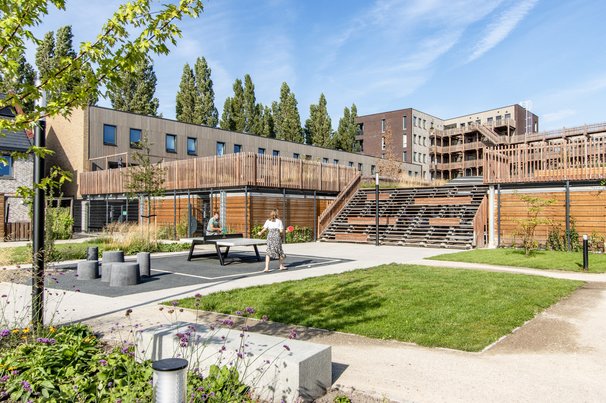14 juni 2016
12 minuten
Cities are becoming increasingly affected by free trade agreements, and many are beginning to engage in related accords with other cities to foster trade, investment and economic development, and other opportunities. These new types of city-to-city networks and agreements are expected to play an increasingly important role in shaping the development agendas of cities in a globalized and networked world.
More than 80 percent of global gross domestic product is generated by cities. In addition, 36 percent of the world’s passenger movements occur in 50 large cities. And 66 percent of the world’s container traffic goes through 50 port cities. Increasingly, the flows of trade, information, corporate capital and passengers are being concentrated in a smaller number of large, economically powerful logistics cities. These are hubs, spokes and main circuit boards of vast national and international logistics and distribution networks, supporting some 10,000 secondary, tertiary, and small towns and cities.
[See: The New Urban Agenda must recognize the importance of intermediary cities]
Increasingly, relationships between cities are becoming more important than those between countries. Global supply chains connect cities, not countries. It is the large and secondary city hubs and ports that are progressively setting the agenda for trade, investment and economic development.
Meanwhile, the city-state is re-emerging as a powerful new player in international trade and development. Competitive and well-run city-states and systems of cities are crucial to making free trade agreements work. As such, a new model of collaborative competition for trade, investment and economic development is emerging between cities and systems of cities.
Underpinning this model is a range of new types of agreements between cities. This is a model that will become more widely accepted as we move towards a more sharing economy, which is primarily concerned with the sharing or leasing of information enabling the optimization of resources and value-adding to economies. As the paradigm of a system or network of city trading states replaces nation states as the principal drivers of trade, investment and economic development, all cities will need to be more aware of the changes and challenges it will bring.
[See: A Miami-Havana ‘Citistate’?]
The concept of collaboration and collaborative competition between cities sounds like an oxymoron. But it is a model that will become increasingly common as cities seek ways to remain competitive, grow their economies and improve the standard of living for their citizens.
In setting a new agenda for Habitat III — the U. N.’s 20-year conference on urbanization, happening in October — it is vital that national governments start to focus on enabling cities to play a more active role in facilitating national economic development, and enhancing trade and economic development opportunities between cities in other countries.
Cities are becoming increasingly affected by free trade agreements, and many are beginning to engage in related accords with other cities to foster trade, investment and economic development, and other opportunities. These new types of city-to-city networks and agreements are expected to play an increasingly important role in shaping the development agendas of cities in a globalized and networked world.
More than 80 percent of global gross domestic product is generated by cities. In addition, 36 percent of the world’s passenger movements occur in 50 large cities. And 66 percent of the world’s container traffic goes through 50 port cities. Increasingly, the flows of trade, information, corporate capital and passengers are being concentrated in a smaller number of large, economically powerful logistics cities. These are hubs, spokes and main circuit boards of vast national and international logistics and distribution networks, supporting some 10,000 secondary, tertiary, and small towns and cities.
[See: The New Urban Agenda must recognize the importance of intermediary cities]
Increasingly, relationships between cities are becoming more important than those between countries. Global supply chains connect cities, not countries. It is the large and secondary city hubs and ports that are progressively setting the agenda for trade, investment and economic development.
Meanwhile, the city-state is re-emerging as a powerful new player in international trade and development. Competitive and well-run city-states and systems of cities are crucial to making free trade agreements work. As such, a new model of collaborative competition for trade, investment and economic development is emerging between cities and systems of cities.
Underpinning this model is a range of new types of agreements between cities. This is a model that will become more widely accepted as we move towards a more sharing economy, which is primarily concerned with the sharing or leasing of information enabling the optimization of resources and value-adding to economies. As the paradigm of a system or network of city trading states replaces nation states as the principal drivers of trade, investment and economic development, all cities will need to be more aware of the changes and challenges it will bring.
[See: A Miami-Havana ‘Citistate’?]
The concept of collaboration and collaborative competition between cities sounds like an oxymoron. But it is a model that will become increasingly common as cities seek ways to remain competitive, grow their economies and improve the standard of living for their citizens.
In setting a new agenda for Habitat III — the U. N.’s 20-year conference on urbanization, happening in October — it is vital that national governments start to focus on enabling cities to play a more active role in facilitating national economic development, and enhancing trade and economic development opportunities between cities in other countries.
Smaller cities smothered
Free trade agreements are expected to benefit the development of countries and regions. But the contribution of cities, especially systems of cities, to the success of those agreements is poorly understood. The agreements do not reflect the range of elements involved in urban and city systems — including economic governance, logistics, infrastructure and human resource management — that are required for them to perform to their potential in support of the agreements.
This is an issue for Habitat III to consider. After all, cities, especially secondary and smaller cities, that are not aware of these emerging phenomenon run the risk of being left behind in the competitive race for trade, investment and local economic development.
[See: How will Latin America deal with its Tolucas?]
The poor performance of urban systems can create significant impediments to trade, direct and foreign investment, and economic development. The inefficiency of such systems adds substantially to business transactions and externality costs. To improve the functionality of cities, it is crucial that urban systems are improved.
Yet improving the infrastructure and efficiency of urban systems will not be sufficient to improve the competitiveness and attractiveness of cities, and to ensure long-term prosperity, higher quality of life, or expansion of trade and development.
For nearly half a century, trade and investment between countries have been driven by models of comparative and competitive advantage. Countries competed for trade and investment based on low labour costs, economies of scale, technology, quality, skills and specialization of products and services.
The big cities have also benefited from the advantages of population size and industry agglomeration, allowing them to compete much more successfully in the global economy for trade and investment. However, many secondary and intermediary cities have missed out on the benefits of this model, and subsequently these areas are highly reliant on the big cities for the many goods and services they need to function and develop.
[See: Will the liveability of intermediate cities lead to megacity problems?]
The current model of city development — which sees large cities capturing an increasing proportion of national jobs, investment, and human capital — is substantially weakening the efficiency of systems of cities. Free trade agreements significantly help to improve the growth and development of the major cities, especially those with populations over 3 million people.
In turn, smaller metropolitan regions and secondary cities are unable to compete against larger cities or to break free of their dependence upon them. They are also unable to gain much in the way of competitive advantage, as they cannot achieve a critical mass to operate at scope and scale. How these cities can overcome these obstacles is a major challenge today — and it will be a significant challenge to the achievement of the U. N.’s Sustainable Development Goal 11 (the urban SDG) and the New Urban Agenda of Habitat III.
New model: Collaborative advantage
For national and international systems of cities to prosper and become more sustainable, a new economic model for development is required. This needs to be based not on competitive but rather on collaborative advantage.
Many international and national firms already recognize the value of collaboration in reducing transaction costs. Collaboration helps to create pools of skilled capital and labour that produce innovation and creativity. Cities can significantly contribute to business development and investment by collaborating to reduce public-sector transaction and externality costs to business and investors.
This calls for collaborative governance arrangements. For instance, cities need to come to agreements to pool, share and provide equitable access to public resources, infrastructure, and services, to reduce externality costs associated with doing business.
[See: New solutions to close the gap on municipal finance]
Embracing collaborative governance, however, is easier said than done. Historically there has been very little trust, and a strong separation of the roles, between the public and private sectors in open-market economies.
In the old model, national governments were the gatekeeper responsible for policy, trade and economic development. Cities were not traditionally involved in international trade and investment, or even in local economic development.
Globalization, free trade and the Internet have challenged this old approach. Under the new model, governments — especially local and city governments — have become more engaged with communities in planning and developing economic policy. Now, many act as facilitators and partners in development.
The next step in the evolution of this model has been for cities to take a direct role by engaging in collaborative governance arrangements. This includes developing networks and partnerships for trade, investment, knowledge and economic development between cities.
For cities to improve their competitiveness, a change to a more collaborative model of governance arrangements is required at three levels. It will require greater collaboration between public agencies within cities and metropolitan regions; between business, government and communities; and between cities, on issues of trade and economic development.
This model calls for cities to engage openly in arrangements to partner with each other to enable small firms to compete for access to new markets nationally and internationally. As this is an area that has traditionally been dominated by firms from large cities, this will be especially important for smaller cities.
[See: Habitat III and metropolitan governance: Time to act]
Associated with city-to-city agreements is the emergence of national and international trade and economic development corridors. Within these, secondary cities become part of a linked chain or network of trading cities within transport corridors.
Some, like the Delhi-Mumbai and the Beijing-Tianjin Jijgjinji corridors, are very large and involve wide-ranging agreements between cities to foster collaboration and integrated regional development. Other such corridors cross multiple countries and will require special agreements to improve the flow of investment, people, goods and services, and co-investment between cities and firms in the critical infrastructure needed to ensure the efficiency of these flows.
These are occurring in Latin America, Africa and Asia, and they are a further extension of trade agreements between cities. Such arrangements will not be without challenges, but countries that choose to ignore the new model for trade and investment based on systems of cities run the risk of being left behind in the race to create sustainable jobs and industries.
Enabling environment: Chicago-Mexico City example
The trade agreement between Chicago and Mexico City signed in 2013 provides a model of city-to-city collaboration that is helping to create new jobs, investment and economic development opportunities. It does so by facilitating trade and investment between similar types of firms and industry clusters in the two cities.
The agreement focuses on four key objectives: economic development; expansion of exports; foreign direct investment; and the fostering of innovation, research, education and human capital development. The accord also identifies eight manufacturing and 13 service-industry clusters where the two cities have agreed to foster collaboration, to support their development and create new jobs.
[See: Habitat III can galvanize city-business collaboration on sustainable urban infrastructure]
A different model is developing in New Zealand, with the establishment of the Core Cities Network. This initiative started in 2011 and involves six of the country’s larger cities working collaboratively to develop international city partnerships and networks aimed at improving economic performance, by enhancing institutional settings.
This latter agreement provides a common baseline for councils and the government to work collaboratively to remove barriers and strengthen the platform for businesses to grow, export and create high-value jobs. A similar project is underway in the United Kingdom, where the central government collaborates with the cities in marketing and development initiatives.
While still in their infancy, these initiatives demonstrate that city leaders can create the conditions and environment to nurture the growth of competitive industries under collaborative agreements. After all, although cities as entities do not trade, the firms and institutions within them do.
What does this look like on the ground? Such agreements can, for instance, encourage co-production between similar types of firms in multiple cities, perhaps involving the initial production of manufactured goods in one city and the final stage in a partnering city.
[See: In the Montréal area, 82 municipalities begin to think and act as one]
Potential also exists to “backload” empty containers travelling between cities — and there are sound economic and environmental benefits to such arrangements. In 2010, there were over 82 million empty container shipments worldwide, with more than 20 percent of the world’s contain shipments being empty. This adds more than USD 1.6 billion to freight costs annually.
Thus, co-production among similar firms and using backloading capacity would substantially reduce transaction costs associated with transport, logistics and production in closer proximity to markets. It also has the advantage of creating employment in partnering cities. Such arrangements can easily become an integral part of city trade, investment and economic development agreements. This was certainly the intent of the Chicago-Mexico City agreement.
Research needed
Still, this is unknown territory. Some studies have looked into the value of collaborative governance at the city level, but very little work has been done on the concept of collaboration agreements on trade, economic development, investment and resource leveraging between cities at a national and international level. This will become very much part of the new agenda for the development of cities.
Significant research is required to advance the development of trade and economic development agreements between cities. While information on trade and agreements between countries has improved substantially, little is known about the nature, volume and value of trade, investment and information flow between cities. At the city level, there is also a poor understanding of how to build enabling environments that support collaborative advantage to foster the development of trade and investment between cities.
[See: Habitat III forum hails rise of ‘cities planning’]
Some investigative work is currently being undertaken by Cities Alliance, the World Bank, the Asia-Pacific Economic Cooperation grouping (APEC) and United Cities and Local Governments (UCLG) on systems of cities and city-to-city trade, investment and development. But substantial additional research is required into ways cities can collaborate and enter into agreements to facilitate new opportunities for sustainable employment and investment, especially in poorer parts of the world.
In the lead-up to Habitat III, there is need to emphasize in the New Urban Agenda that the sustainable development of cities is something that requires greater collaboration between cities. After all, city trade and investment, economic and social ties are replacing the historic arrangements between nation states.
The development of strong national and international systems of cities calls for greater collaboration between cities, involving a wide range of formal and informal arrangements, agreements, networks and partnerships. This will create challenges, but the benefits in meeting the SDGs and support for a New Urban Agenda and beyond will be significant.
BRIAN H. ROBERTS - JUNE 6, 2016
Cover: ‘cities’




